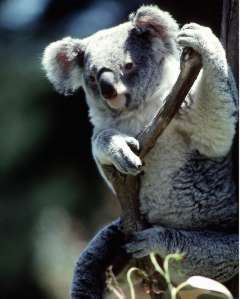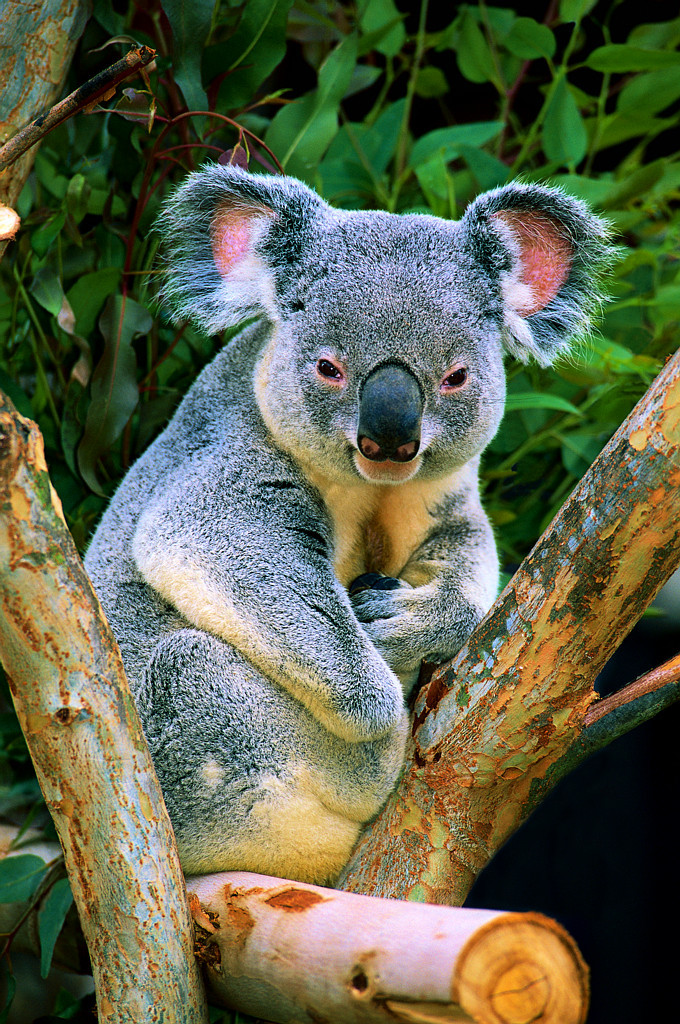Overview
 Order: Diprotodontia
Order: Diprotodontia
Family: Phascolarctidae
Species: Phascolarctos cinereus
Distribution: East Australia
Habitat: Dry forest
Size: These measurements are the average for koalas in the South of their range; the ones in the North are quite a lot smaller. Head - body length: Male - 78 cm Female - 72 cm Weight: Male - 12kg Female - 8 kg
Gestation: 34 - 36 days
Life Span: Up to 13 years (18 years in captivity)
The koala is perhaps the best-loved of all Australia's marsupial, or pouched, mammals. Although it
is rather bear-like in appearance, its nearest relatives are the opossums. Tailless, except for a very short stump, the koala has thick ash-grey fur, tinged with brown on the upper parts and it is white on the under parts.
A Tree-Top Life: The koala spends most of its time shuffling around the topmost branches of Eucalyptus, or 'gum' trees, hanging on tight with its four grasping feet. It sleeps during the day, curled up in a tree-fork and feeds at night on the leaves and shoots of a few species of Eucalyptus. An adult will eat about 500g of leaves a day.
Breeding
During the summer, a male koala collects a small harem of females and guards them closely from rivals. After a gestation period of 34-36 days, there is normally only one baby born. It measures only 2cm in length and weighs a mere 0.5g. The tiny creature climbs into its mother's backward opening pouch (other way round to a kangaroo's pouch) and stays there for 5 or 6 months, feeding on milk. After it leaves the pouch, it rides 'piggy-back' on its mother for another 6 months, and to begin with, she feeds it on partially digested food that has passed through her digestion system. The young one is independent by 11 months of age and it may live close to the mother for a few more months.
Protecting the Koala
In the early years of this century there were millions of koalas. Now there are thousands. The decline in numbers began in 1887 when for two years, and again in 1900 for three years, disease killed many. Also at that time, a favourite 'sport' was to shoot koalas as they sat in their tree-tops. Over the years, koalas have been killed by forest fires and their habitat destroyed to make way for agriculture and towns. There used to be a market for their thick, beautiful fur. In 1924 over 2 million koala pelts were exported. Fortunately, the public began to object strongly to this ruthless slaughter and sanctuaries were set up for them. Koalas are now fully protected and are not currently classed as a species under-threat.
Threats to the Koala
 The koala is known all over the world for its cute and cuddly bear-like looks, but these animals aren't really bears, they're marsupials and are related to the kangaroo.
The koala is known all over the world for its cute and cuddly bear-like looks, but these animals aren't really bears, they're marsupials and are related to the kangaroo.
In January 2015 there were estimated to be 2,000 to 8,000 koalas in the wild. Among the problems that threaten them is habitat destruction. When it comes to habitats koalas are fussy customers as they only eat leaves from eucalyptus trees and so are only found in woodlands or forests that contain that yummy vegetation. Many trees and woodland areas are being cut down for new buildings, farmland, mining projects or roads leaving koalas and lots of other wildlife with a lack of suitable habitat, food, shelter and safety.
Another threat is climate change. Increasing CO2 levels are known to affect the amount of nutrients found in the leaves of eucalyptus trees - the koalas' only food source. Climate change is also predicted to increase bush fires and droughts in Australia - conditions which aren't favourable to the tree dwelling and slow moving mammal. Other threats include road traffic and attacks from dogs.
Will the koalas have a happy ending? Hopefully with the help of conservation projects and a better understanding of their habits and habitats locals, businesses and governments can help to keep koala numbers up.
To find out more visit the Australian Koala Foundation and download this PDF by the IUCN about the species most likely to be affected by climate change.
Credits
Image: Koala by Justin Brown
Infomation sourced from:
Koalaexpress (2015), KOALA FACTS [online], Available from: http://www.koalaexpress.com.au/facts1.htm [accessed 01/07/2015].
The IUCN Red List of Threatened Species (2015), Phascolarctos cinereus [online], Available from: http://www.iucnredlist.org/search [accessed 01/07/2015].
 Order: Diprotodontia
Order: Diprotodontia
 The koala is known all over the world for its cute and cuddly bear-like looks, but these animals aren't really bears, they're marsupials and are related to the kangaroo.
The koala is known all over the world for its cute and cuddly bear-like looks, but these animals aren't really bears, they're marsupials and are related to the kangaroo. 